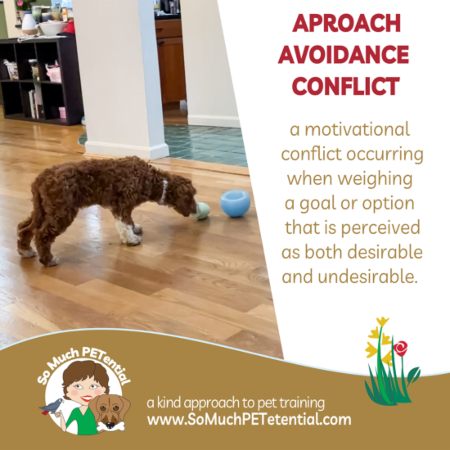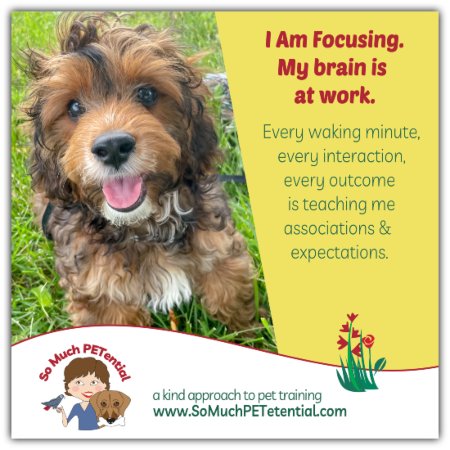I smile every time I see this video of Auggie, an aussiedoodle client of mine, and the little puppy. When a larger dog – who rumbles and tumbles and chases with the best of the other large dogs – flops over on her belly with loose muscles to play differently with a puppy or small dog, that larger dog is self-handicapping. You have more than likely seen dogs do it. People actually practice it also. I thought I’d write more about self-handicapping in dog play and what you can do to encourage it.

Every dog, person and other living being is its own individual with varying size, ability and strength. Self-handicapping refers to how a dog will inhibit its intensity, speed and style of behaviors to better match that of its playmate. No one enjoys playing with someone else who always overpowers the other. It has a way of deflating the underdog and discouraging further engagement. Self-handicapping helps to level the playing field so to speak. It can keep the game going longer – for both players.
Examples of this in dog play include rolling over to expose the belly, making their body appear smaller, limiting the power in their tugging or even giving away their toy to the other. When you watch Bette and Miles play, you see how Bette rolls over (and then later stands up), and a few minutes later they are both laying on their backs next to each other. This play session lasted for several minutes.

Self-handicapping also can include interactions like a dog laying down with loose muscles softly pawing toward a cat. Adults may hit a tennis ball softer and directly toward a young child but may use a lot of strength aiming to keep the ball away from another adult opponent on the court.
toward a young child but may use a lot of strength aiming to keep the ball away from another adult opponent on the court.
While it seems so effortless to watch, self-handicapping behaviors actually require a lot of self-control and ability to read and understand the other’s communication. Remember, that animal must continually be monitoring the actions of its playmate watching for signs of disengagement vs engagement, hard body vs loose body muscles, safety vs danger.
But also, as Dr. Patricia McConnell pointed out, “here’s the challenge. self-handicapping requires a lot of emotional control, and the irony about play is that part of its fun is that we can throw aside some of our inhibitions and lose a little bit of control. I suspect this is where a lot of dogs get into trouble. Playing, which often involves the same actions as fighting, can result in high arousal and a lack of inhibition… and spill over into aggression a bit too easily.”
Or you may also see that your dog just calls it quit on the playing all together because it just isn’t a fun or reinforcing activity any longer.
Excellent adult dog communicators, as well as human caregivers of puppies and dogs can play an important role in teaching how to start and stop play, how to be able to wait, be called away and take breaks.
Recall, sitting and laying down are all good skills to teach your young dog, practicing them in different contexts and different environments. You can then practice interrupting play BEFORE it gets too intense by asking for one or several of those behaviors and then releasing your puppy or dog for more play.







